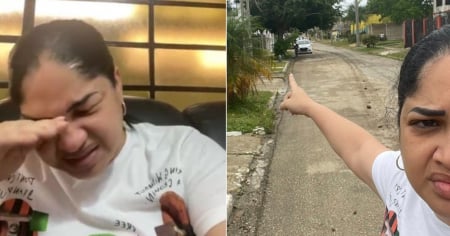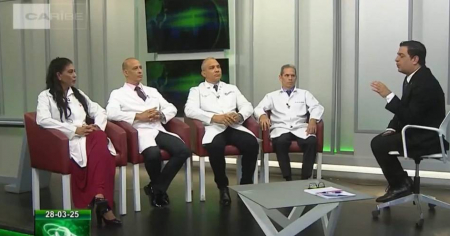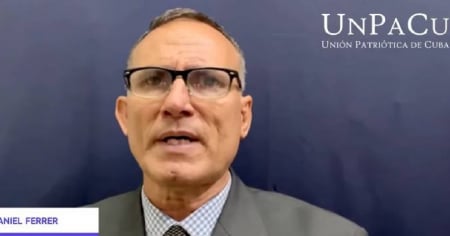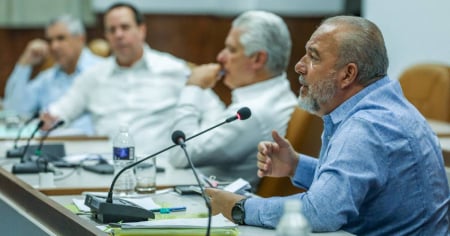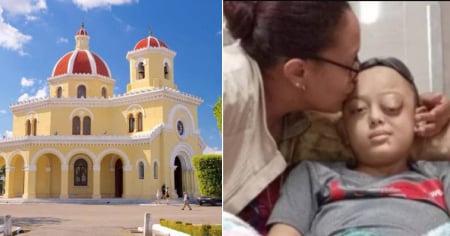At 4:00 p.m. on Wednesday, a mass for the eternal rest of the child Geobel Damir Ortiz began in the chapel of Colón Cemetery in Havana. He passed away in Miami after several years of unsuccessful treatments and questionable medical care on the island.
The religious ceremony was organized by family, friends, and activists who, despite the regime's threats, came together in prayer for the memory of the young child.
Damir's grandmother, Mercedes Báez, arrived accompanied by Daniel, her trusted caregiver.
Visibly affected, Mercedes received expressions of affection and support from those who gathered to accompany her in her sorrow. "All she wants is to pay tribute to her grandson," several attendees remarked.

However, the farewell ceremony was not without obstacles imposed by the Cuban regime. Activist Lara Crofs (real name, Yamilka Lafita), who was involved in organizing the mass, reported that she was held at home by State Security agents and was prevented from attending the religious event.
"They closed off my block to prevent me from going out. Today is not a day for confrontation, but I can't keep quiet about my frustration," Lafita expressed through a live broadcast on social media, where she also showed images of the patrol cars positioned in front of her home.
The activist noted that her absence would not change the essence of the tribute: “It’s not about me. It’s a community that wants to pay homage with love and empathy.”
Despite the repression, the mass is being held as scheduled, presided over by Father Jorge Luis, in an atmosphere of reflection, prayer, and solidarity.
During the ceremony, a prayer was raised not only for Damir but for all the sick children in Cuba. “Lord, have mercy,” was heard spoken in unison amidst tears and prayers.
Meanwhile, on social media and independent media, messages of support for Damir's family and outrage at the regime's attempts to politicize the case of the boy Damir are multiplying, which has rallied thousands of Cubans both inside and outside the country in recent months.
Following the reports from the child's mother, which intensified over the last two years due to the shortage of medicines in Cuba, thousands of Cubans began to support the case, ultimately securing, albeit too late, the child's transfer to Nicklaus Children's Hospital in Miami.
However, he arrived at the facility in septic condition due to a highly resistant bacteria that he could not overcome as a result of improper antibiotic management.
Her mother has received support from the Cuban community in Miami, where a tribute was held.
Frequently Asked Questions about the Mass and the Situation of the Child Damir Ortiz
Why was the mass in memory of Damir Ortiz significant?
The mass in memory of Damir Ortiz was significant because it represented an act of love and solidarity from the Cuban community, both inside and outside the island, towards the child and his family. It was an opportunity for family members, friends, and activists to pay tribute to Damir in an atmosphere of reflection and prayer, despite the restrictions imposed by the Cuban regime.
What obstacles did the activist Lara Crofs face in attending the mass?
The activist Lara Crofs, whose real name is Yamilka Lafita, was held in her home by State Security agents and was prevented from attending the mass. Despite these repressive actions, Lara emphasized that her absence would not change the essence of the tribute to Damir, which was an act of compassion and solidarity from the Cuban people.
What role did Damir's mother play in obtaining medical treatment in the U.S.?
The mother of Damir, Eliannis Ramírez, was a key figure in the campaign to move her son to the United States in search of specialized medical treatment. Despite the bureaucratic hurdles imposed by the Cuban regime, her tireless struggle and the solidarity of the Cuban community allowed Damir to be transferred to Miami, where he received medical care.
How did the Cuban community react to the death of Damir Ortiz?
The Cuban community reacted with shock and pain to the death of Damir Ortiz. His case mobilized thousands of people who expressed their solidarity and demanded justice in the face of the negligence and bureaucratic obstacles they encountered. Social media was flooded with messages of support for the family and outrage over the situation of the Cuban healthcare system.
Filed under:

